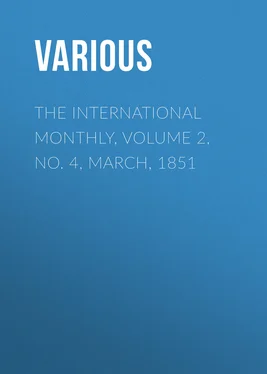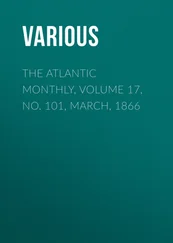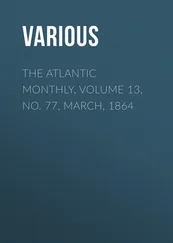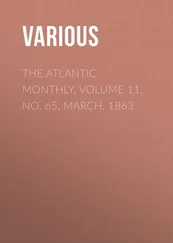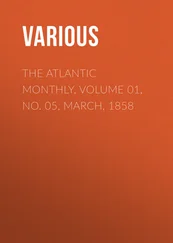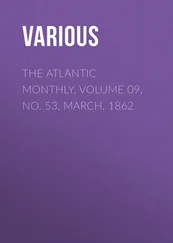Various - The International Monthly, Volume 2, No. 4, March, 1851
Здесь есть возможность читать онлайн «Various - The International Monthly, Volume 2, No. 4, March, 1851» — ознакомительный отрывок электронной книги совершенно бесплатно, а после прочтения отрывка купить полную версию. В некоторых случаях можно слушать аудио, скачать через торрент в формате fb2 и присутствует краткое содержание. Жанр: foreign_antique, periodic, foreign_edu, на английском языке. Описание произведения, (предисловие) а так же отзывы посетителей доступны на портале библиотеки ЛибКат.
- Название:The International Monthly, Volume 2, No. 4, March, 1851
- Автор:
- Жанр:
- Год:неизвестен
- ISBN:нет данных
- Рейтинг книги:5 / 5. Голосов: 1
-
Избранное:Добавить в избранное
- Отзывы:
-
Ваша оценка:
- 100
- 1
- 2
- 3
- 4
- 5
The International Monthly, Volume 2, No. 4, March, 1851: краткое содержание, описание и аннотация
Предлагаем к чтению аннотацию, описание, краткое содержание или предисловие (зависит от того, что написал сам автор книги «The International Monthly, Volume 2, No. 4, March, 1851»). Если вы не нашли необходимую информацию о книге — напишите в комментариях, мы постараемся отыскать её.
The International Monthly, Volume 2, No. 4, March, 1851 — читать онлайн ознакомительный отрывок
Ниже представлен текст книги, разбитый по страницам. Система сохранения места последней прочитанной страницы, позволяет с удобством читать онлайн бесплатно книгу «The International Monthly, Volume 2, No. 4, March, 1851», без необходимости каждый раз заново искать на чём Вы остановились. Поставьте закладку, и сможете в любой момент перейти на страницу, на которой закончили чтение.
Интервал:
Закладка:
Candidates for admission to the Free Academy must have passed at least one year in the public schools, and they are examined in the common English studies. The standards for admission are not so high as the colleges demand, because the period of instruction is longer. We cannot enter into any particular statement of the courses of study, but it will be interesting if we indicate their character very briefly, and describe the chief teachers. Edward C. Ross, LL. D., the Professor of Mathematics, is, like Dr. Webster, a graduate of the Military Academy, and was many years a successful teacher in that institution and in Kenyon College. He is assisted by G. B. Docherty, A. M., who was formerly the Principal of the Flushing Institute. The course embraces all the studies necessary for the best accomplishment in engineering, and indeed is as thorough and complete as that pursued at West Point, with the modifications appropriate to the prospective pursuits of the pupils. Theodore Irving, A. M., is Professor of History and Belles-Lettres, assisted by Edward C. Marshall, A. M., and G. W. Huntsman, A. M. These gentlemen have experience, and we believe their system of instruction is in some respects original and in every way very excellent. Mr. Irving is a kinsman of "Geoffrey Crayon," and himself master of a pleasing and classical style. Oliver Wolcott Gibbs, A. M., M. D., Professor of Chemistry, Natural Philosophy, Mineralogy, and Geology, is one of the best practical chemists in this country, having completed his own education under the celebrated Liebig, in Germany, and since in many ways evinced such capacities in this department, as made his selection for the place he occupies almost a matter of course. John J. Owen, D. D., whose scholarship is exhibited in his ably edited series of the classical authors of these languages, is Professor of Greek and Latin, and we neither agree with nor have much respect for those who deprecate the attention demanded in the Academy for such studies. The French, Spanish and German languages are taught by Professors Roemer, Morales, and Glaubensklee, all of whom are known to the public for such talents as are necessary in their positions. Mr. Paul P. Duggan, a painter whose works adorn many of our best collections in art, is Professor of Drawing.
The Free Academy will fulfil the reasonable expectations of its founders. It is admirably designed, and its appointments and administration have thus far been judicious. We lack yet a University: there is no school in America deserving this title; all our colleges should be regarded as gymnasia , sifting the classes of the common schools and preparing their more advanced and ingenious pupils for such an institution; and the Free Academy may be accepted as a model by which they can be reshaped for their less ambitious but more appropriate duties. This is a subject ably and properly treated in Professor Tappan's recent volume on Education, (published by Mr. Putnam,) to which we beg attention.
The whole number of students now attending the Free Academy is three hundred and twenty-nine, of whom one hundred and five were admitted at the last examination, in February. The number for whom the building is designed is about six hundred.
Authors and Books
A book which we cannot too highly recommend is the Briefe über Humboldt's Kosmos (Letters on Humboldt's Cosmos), published at Leipzic, in two octavo volumes, from the pens of Professor Cotta and Professor Schaller. It is intended to serve as a commentary upon that work, which it is well worthy to accompany. Without attempting an exhaustive treatise on the details of the various topics touched on by Humboldt, the writers have expanded some of the leading points of his work into scientific essays, whose practical utility is none the smaller for an elegant and attractive style, and a genial enthusiasm, of which Humboldt need not be ashamed. The first volume, by Professor Cotta, contains forty letters on the following themes: The enjoyment of nature; matter and forces, growth and existence; natural philosophy; the fixed stars, their parallaxes, groups, movements, nebulæ; double stars, structure of the universe, resisting medium; the solar system; the laws of motion, Kepler and Newton; density of the heavenly bodies; our moon, its orbit, no atmosphere, no water; comets; meteors, and meteoric stones; form of the earth; magnetism; volcanic activity; gas-springs; geysers; internal structure of the earth; history of organisms, their first origin, and developments; the surface, its forms, and their influence on animated life; the gradual rising and sinking of the surface in Sweden; the tides; circulation of water on the earth—springs, cold, warm, mineral, artesian—rivers, seas, ocean currents, evaporation and condensation; glaciers; the atmosphere, climate, weather, winds, storm-clouds; organic life on the earth, its nature, differences, origin of the differences, original production, creation, first appearance; man, his origin, races, forms, phrenology, &c. These letters offer, as we have already said, in a pleasing and attractive form, a condensed and comprehensive view of what is now known with reference to the sciences treated. The letter upon Man is especially interesting. Professor Cotta belongs to those who think the human race to be "the gradual perfection, through thousands of generations," of a lower order of creatures. "The human individual," he says, "even now, in the embryonic state, passes through the condition of various sorts of animals. The most eminent anatomists have shown that before birth we for a time resemble a polypal animal, then for a time a fish, next a reptile, till at last appear the characteristics of a mammalia. This is a fact which bears strongly in favor of our view. The genesis and development of the entire species seem to be here condensed in the growth of the individual." But while setting forth this peculiar view, Professor Cotta, with true German comprehensiveness, takes care to give a fair statement of opposing doctrines, and evinces nothing like a narrow dogmatism. The second volume, like the second volume of the Cosmos, is that which will most interest and delight the general reader. It contains thirty-two letters, mainly on the following subjects: the view of nature in general; the religious view; the various forms of the religious view; the æsthetic view; the inward connection of the æsthetic enjoyment of nature with its artistic representation; the scientific view as empirical science and natural philosophy; the relations of the various views of nature to each other; the poetic comprehension of nature among the Indians; the poetic comprehension of nature among the Jews, the Greeks, and the Romans; the Christian contemplation of nature; German poetry in the middle ages; Italian poetry; the poetic comprehension of nature in modern times; the representation of nature by painting, and its gradual appearance in the history of art; the physiognomy of plants in connection with the physiognomy of nature in general; description of several plant formations; general outlines of the animal world; history of the physical view of the universe; natural science among the Phenicians, the Greeks, at the time of the Ptolemies, at the time of the Roman Empire, and in the middle ages; natural history of modern times, Bacon, Copernicus, Kepler, Galileo, Newton; the mechanical doctrine of modern physics; the dynamic view of nature; Fichte's doctrine, and the natural philosophy of Schelling and Hegel. This volume, as will be easily understood, gives at once a history of religion, philosophy, art, literature, and science, in their relations to the outward universe. For instance, under the head of natural science among the Greeks, we have among other things an account of the doctrine of the Pythagoreans, Plato, and Aristotle; in treating the middle ages, Professor Schaller speaks of the Scholastics, Thomas Aquinas, Roger Bacon, Giordano Bruno, and Paracelsus. One of the most interesting parts of the whole is that on the poetic view of nature among the Hindoos, Jews, Greeks, Romans, Germans, and Italians, the historical statement being every where illustrated by copious quotations of admirable passages from the poets of those nations. The strictly scientific portions are illustrated by excellent engravings, and are free from mere technicalities. Sold in New-York by R. Garrigue.
Читать дальшеИнтервал:
Закладка:
Похожие книги на «The International Monthly, Volume 2, No. 4, March, 1851»
Представляем Вашему вниманию похожие книги на «The International Monthly, Volume 2, No. 4, March, 1851» списком для выбора. Мы отобрали схожую по названию и смыслу литературу в надежде предоставить читателям больше вариантов отыскать новые, интересные, ещё непрочитанные произведения.
Обсуждение, отзывы о книге «The International Monthly, Volume 2, No. 4, March, 1851» и просто собственные мнения читателей. Оставьте ваши комментарии, напишите, что Вы думаете о произведении, его смысле или главных героях. Укажите что конкретно понравилось, а что нет, и почему Вы так считаете.
